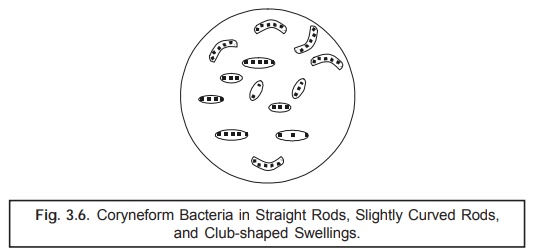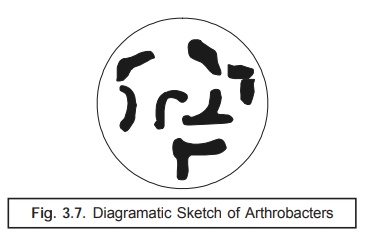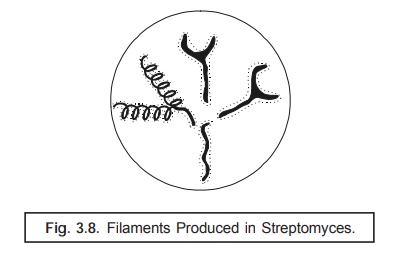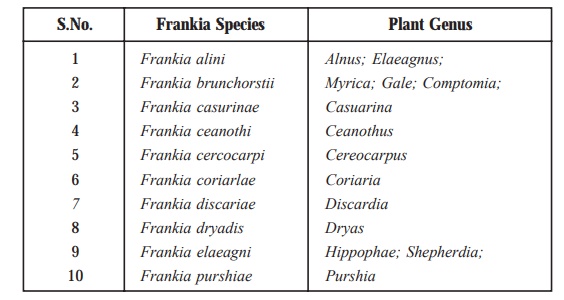Actinomycetes and Related Organisms
| Home | | Pharmaceutical Microbiology | | Pharmaceutical Microbiology |Chapter: Pharmaceutical Microbiology : Characterization, Classification and Taxonomy of Microbes
This particular section essentially comprises of a relatively heterogenous division of a large cross-section of microorganisms having altogether diverse characters including: group, genus, order, and family, as outlined below :
Actinomycetes and Related
Organisms
This particular section essentially comprises of a relatively heterogenous division of a large cross-section of microorganisms having altogether diverse characters including: group, genus, order, and family, as outlined below :
(a) Group: Coryneform
(b) Genus: Arthrobacter, Cellulomonas,
Kurthia, Propionibacterium
(c) Order: Actinomycetales, and
(d) Family: Actinomycetaceae,
Mycobacteriaceae, Frankiaceae, Actinoplanaceae, Nocardiaceae,
Streptomycetaceae, Micromonosporaceae.
All the
aforesaid divisions shall now be treated individually and briefly in the
sections that follows.
Group [Example : Coryneform]
The coryneform group essentially comprises
of organisms that have the following three
charac-teristic properties, namely :
·
These are Gram-positive in nature
·
These are non-spore forming rods of irregular
outline, and
·
These are represented by diverse species.
Species: The species belonging to the
coryneform group includes microbes three individual sections
which would be treated separately in the sections that follows.
(a) Human and animal parasites and pathogens :
Importantly, the bacteria which are intimately associated with this section are
observed to be straight to slightly curved rods, and invariably appear as
club-shaped swellings, as shown in Fig. 3.6.

Salient Features : The
salient features of coryneform bacteria are
as follows:
(1) They
are usually non-motile, Gram-positive, and non-acid fast.
(2) They
are mostly chemoorganotrophs, aerobic, and also facultatively anaerobic.
(3) They
are widely distributed in nature with % (G + C) values ranging between 52 to 68
moles per cent.
(4) The
type species belonging to this class is represented by C. diphtheriae which is particu-larly known to produce a highly lethal exotoxin and causes the dreadly
disease in humans called diphtheria.
(b) Plant pathogenic corynebacteria:
Interestingly, the bacteria belonging to this particular class is closely akin
to those present in section (a)
above; however, these are essentially characterized by three prominent features, namely: (i) less pleomorphic, (ii) strictly aerobic in nature, and (iii)
possess % (G + C) values ranging between 65–75 moles per cent.
Based on
ample scientific evidences, this particular section is further sub-divided into
four categories, such as: (i) types of polysaccharide antigens, (ii)
composition of amino acids present duly in cell walls, (iii) minimal nutritional requirements, and (iv) etiology of the disease caused in plants.
(c) Non-pathogenic corynebacteria: This
particular section essentially consists of non-pathogenic corynebacteria quite
commonly derived and isolated from soil, water, air, and are invariably
described in the literature very scantily by virtue of their morphological similarities and hence,
the virtual scope of any possible distinct differentiation.
Genus
The four prominent genus shall be treated individually in the sections that follows:
(a) Arthrobacter: The genus Arthrobacter essentially consists of such organisms that undergo a
marked and pronounced change in form particularly in the course of their
respective growth on the complex media. It
has been duly observed that the relatively
‘older cultures’ do comprise of coccoid cells* very much resembling to micrococci in their appearance. In certain specific instances, the
cells could be either spherical to ovoid or slightly elongated. Importantly, when
these are carefully trans-ferred to the ‘fresh
culture media’, consequently the ultimate growth takes place by two distinct modes, namely : (a) due to swelling, and (b) due to elongation of the coccoid cells, to
produce rods that essentially have a
diameter precisely much less in comparison to the corresponding enlarged cells.
Eventually,
there may be predominant ‘outgrowths’
occurring at more than one segment of the cell as depicted in Fig. 3.7.

Arthrobacter’s
subsequent growth and followed up divisions usually yields irregular rods that
vary appreciably both in size and shape.
Importantly,
a small segment of the rods are invariably arranged at an ‘angle’ to each other thereby causing deformation. However, in
richer media, cells may exhibit preliminary (rudimentary) branching, whereas
the formation of true mycelia cease
to form. Besides, along with the passage of the ‘exponential phase’, the rods turn out to be much shorter and get
converted to the corresponding coccoid
cells. A few other prevalent characteristics are as follows:
·
Rods are either non-motile completely or motile by
one sub-polar or a few lateral flagella.
·
Coccoid cells are Gram-positive in nature,
chemoorganotrophic, aerobic soil organisms hav-ing a distinct respiratory metabolism.
·
Species present within the genus are invariably categorized
and differentiated solely de-pending on the composition of cell wall;
hydrolysis of gelatin, starch etc.; and the ultimate growth-factor requirement.
It is,
however, pertinent to state here the two
other genera although whose actual and precise affiliation is still ‘uncertain’, yet they are quite related
to the Arthrobacter, namely: Brevibacterium
and Microbacterium.
(b) Cellulomonas: The genus Cellulomonas essentially comprises of bacteria that have the
com-petence and ability to hydrolyse the cellulose
particularly.
Salient Features : The
various vital and important salient features are as stated below:
(1) The cells usually observed in young cultures are irregular rods having
a diameter nearly 0.5 μm and a
length ranging either between 0.7 to 2 μm or even
slightly in excess.
(2) The
appearance of the cells could be
straight, slightly curved, or angular or beaded or occa-sionally club-shaped.
(3) Importantly,
certain cells may be arranged
strategically at an angle to each other as could be observed in the case of Arthrobacter [see section 5.1.4.2(a)]; besides, they (cells) may infre-quently exhibit rudimentary branching as well.
(4) Older cultures are invariably devoid of ‘true
mycelia’ but the ‘coccoid
cells’ do predomi-nate in number.
(5) The cells may be Gram-positive to
Gram-negative variable, motile to non-motile variable, non acid-fast, aerobic
chemo-organotrophos, having an optimum
growth temperature at 30°C.
(6) The %
(G + C) values ranges between 71.7 to 72.7 moles.
Interestingly,
there exists only one species, Cellulomonas
flavigenum, which is exclusively known and recognized; and found commonly
in the soil.
(c) Kurthia: The genus Kurthia is specifically characterized by organisms that are
prominently and rigidly aerobic in nature;
besides, they happen to be chemoorganotrophs.
Young cultures essen-tially comprise
of cells that are mostly unbranched rods having round ends, and occurring as
distinct parallel chains. Older cultures
normally comprise of coccoid cells that
are critically obtained by the fragmentation
of rods.
Salient Features: The
salient features of the organisms belonging to the genus Kurthia are as given under:
(1) The
rods are rendered motile by the
presence of peritrichous flagella*.
(2) The cells predominantly grow in abundance,
particularly in the presence of sodium chloride (NaCl) solution [4 to 6% (w/v)]
prepared in sterilized distilled water.
(3) The
optimum temperature required for the healthy growth of the cells usually varies
between 25 to 30°C.
Interestingly,
there prevails only one species, Kurthia
zoefi, that has been duly recognized and described in the literature.
There are
certain characteristic features of the genera Corynebacterium, Arthrobacter, Cellulomonas,
and Kurthia that have been duly summarized
in Table 3.8.

(d) Propionibacterium: The
family Propionibacteriaceae
invariably consists microbes that
have the following characteristic features :
(i) They
are all Gram-positive, non-spore forming, anaerobic to aerotolerant,
pleomorphic, branching or filamentous or regular rods.
(ii) On
being subjected to ‘fermentative
procedures’ it has been duly observed that the major end-products
ultimately generated are, namely : propionic
acid, acetic acid, carbon diox-ide, or a mixture of butyric, formic, lactic together with other monocarboxylic
acids.
(iii) Growth: Their normal growth is usually
enhanced by the very presence of carbon dioxide, and
(iv) Habitat: These microbes are normally
inhabitants of skin, respiratory, and the intestinal tracts of a large
cross-section of animals.
A survey
of literature would reveal the description of two genera, namely : Propionibacterium
and Eubacterium. These two genera shall now be dealt with
briefly and separately in the sections that follows:
Propionibacterium: The genus Propionibacterium predominantly comprises of such bacterial cells
that happen to be virtually non-motile, anaerobic to aerotolerant, and
essentially give rise to propionic acid as
well as acetic acid.
Salient Features: The bacterial cells do have the following
salient features, such as :
(1) They
are quite often arranged in pairs, singles or ‘V’ and ‘Y’ configurations.
(2) These
are actually chemoorganotrophs which
eventually attain growth very rapidly between a temperature ranging between
32–37°C.
(3) A
large and appreciable quantum of strains do grow either in 20% (w/v) bile salts
or 6.5% (w/v) sodium-chloride/glucose broth.
(4)
Certain species are observed to be pathogenic in nature.
However,
the genus Propionibacterium essentially includes eight species that have been
duly identified, characterized, and recognized entirely based upon their end
products derived from their respective metabolism.
Eubacterium: The genus Eubacterium comprises prominently of such bacterial cells that could be either motile or non-motile, obligatory anaerobic, and lastly
either non-fermentative or fermentative in nature. It has been adequately
demonstrated that particularly the fermentative
species give rise to mixtures of organic acids, viz., butyric, acetic, formic or lactic, or even other
monocarboxylic organic acids. Besides, these bacterial cells undergo both
profuse and rapid growth at 37°C, and are invariably observed to be located
strategically in the various marked and pronounced cavities in humans, animals, soil, and plant products.
Interestingly,
there are certain species belonging to this genus which exhibit distinct
pathogenicity.
Order:
The order Actinomycetales shall be treated at
length in this particular section.
Importantly,
Actinomycetales do contain such
members that necessarily have a typical and prominent tendency to produce the ‘branching filaments’ in particular,
which in certain instances ultimately develop into a full-fledged mycelium. Interestingly, the family: Mycobacteriaceae — does possess extremely short filaments ; whereas,
the family : Streptomycetaceae — does
exhibit distinctly well-developed filaments. Fig. 3.8. illustrates the
filaments duly formed in the specific case of streptomyces.

Salient Features: The salient features of the
filaments/spores occurring in various families are as stated under:
(1) The
diameter of the filaments in Streptomyces
ranges between 0.2 to 2 μm.
(2) A few
families do possess such filaments
that usually tend to fragment; and subsequently the ensuing fragmentation gives
rise to coccoid, elongate, or diploid bacterial cells.
(3) In
certain families, one may observe the formation of ‘true spores’ occurring specifically either on aerial or substrate hyphae.
(4) Invariably,
spores may be produced either singly
or in chains that could be straight,
looped, or spiral in appearance;
and such chains usually come into being either singly or in a verticillate* manner.
(5) It
may be seen that the spores are duly
borne in sporangia as in the
particular instance of the family : Actinoplanaceae,
which could be either motile or non-motile. Importantly, the or-ganism
though is Gram-positive in character, but the aforesaid reaction might change
with aging.
(6) The characteristic
features of certain other family members of the order Actinomycetales are as given under:
(a) Mycobacteriaceae: are acid fast in character
(b) Nocardiaceae: are found to be weakly acid-fast in nature
Family :
There are
in fact, seven prominent families belonging
to the category of Actinomycetes and
Related Organisms, which shall be treated individually in the sections that
fol-lows:
(a) Actinomycetaceae : The
cardinal characteristic features of the family Actinomycetaceae are as follows:
(1) Bacteria
are predominantly ‘diploid’ in shape
that have been observed to exhibit a clear tendency to give rise to the
formation of branched filaments during
certain stages of their ‘cultural
development’.
(2) Evidently,
the fragmentation of filaments invariably takes place quite rapidly to produce diploid as well as coccoid cells.
(3) The
formation of ‘aerial mycelium’ and ‘spores’ do not take place at all.
(4) The
bacterial cells are non-motile that invariably extend their growth as anaerobic facultatively, whereas quite a few may turn out to be either
absolutely anaerobic or aerobic in nature.
It has
been duly observed that the family Actinomycetaceae
has five distinct genera exclusively based upon their
intimate (direct) relationship to oxygen.
(b) Mycobacteriaceae: The
salient features of a large segment of the members belonging to the family Mycobacteriaceae are as stated under :
(1) Invariably
most of its members are pathogenic
in nature.
(2) The
bacterial cells are slightly curved or straight rods which are occasionally
exhibited in a ‘branching mode’.
(3) Importantly,
both mycelium and filamentous type growths are generally
found ; and even-tually they get fragmented into the corresponding rods or coccoid cells.
(4) The bacterial cells are usually found to be
acid-fast, non-motile, and failed to give rise to the formation of endospores,* conidia,** and capsules.***
(5) The bacterial cells are usually
characterized specifically by a relatively much higher lipid content and
are also comprised of long, branched chains of mycolic acids.****
Importantly,
the genus Mycobacterium includes
prominently the host of such critical and vital components as: obligate parasites, saprophytes, and intermediate forms which do vary in
their nutri-tional requirements appreciably. Besides, all microbes are usually
aerobic in nature, and a possible growth may take place very much in depths of
the ensuing medium. Generally, they are found in warm/ cold blooded animals,
soil and water; whereas, the % (G + C) values range between 62–70 moles per
cent.
(c) Frankiaceae: The family Frankiaceae predominantly comprises of such organisms that are symbiotic, mycelial, and filamentous in nature. Besides, they
are capable of inducing and residing particularly
in the root modules of a large cross-section of non-leguminous dicotyledonous plants as summarized in Table 3.9.
Table 3.9. Non-leguminous Nodule-bearing
Dicotyledonous Plants with Frankia Species as Endophyte

(d) Actinoplanaceae: The
family Actinoplanaceae consists of
microorganisms which do pos-sess the following characteristic features, such as
:
(1) They
give rise to distinct mycelia that
may be either intramatrical or
occasionally aerial in nature.
(2) The filaments have a diameter ranging
between 0.2 to 2.6 μm mostly.
(3) Importantly,
the sporangiospores are usually
produced either on branched or unbranched hyphae.
These are of two
distinctly different shapes, namely :
(i) Having
large spherical to specific irregular multisporous sporangia, and
(ii) Having
small club-shaped or filiform sporangia consisting of one to several spores.
However,
the spores could be either motile or non-motile. These two different fruiting structures are vividly illustrated in Fig.
3.9(a) and (b).

(4) These
are invariably Gram-positive chemoorganotrophs having a respiratory metabolism
which being aerobic in nature and available abundantly in particular humus rich soil.
(5) The
family exclusively comprises of ten (10) genera that may be grouped into two broad divisions as described in
section (3) above.
(e) Nocardiaceae: The family Nocardiaceae essentially and solely comprises of aerobic actinomycetes wherein the mycelium could be present either in the rudimentary (elementary) or in an extensive form. It has been duly
observed that ‘sporogenesis’ i.e., the production of spores significantly
varies with the genus. It is,
however, pertinent to state here that Nocardiaceae
possesses prominently two genera,
namely: Nocardia, and Pseudonocardia.
Nocardia — It has the following characteristic
features, such as:
(1) Possesses
specific spores not produced on differentiated hyphae.
(2) Essentially
the reproduction bodies are typical mycelial fragments that are produced quite
irregularly either in the aerial hyphae
or in the substrate.
(3) The genus Nocardia is usually further categorized into three distinct morphological groups that are solely based upon the
critical extent of the specific mycelial development.
(4) The %
(G + C) values ranges between 60 to 72 moles per cent.
(5) Importantly,
the carotenoid pigments (viz., β-carotene)
are usually produced by various species.
Pseudonocardia : This particular genus essentially comprises of two distinct species, namely: P.
thermophilia and P. spinosa. Importantly,
both aerial as well as substrate hyphae are duly gener-ated. The spores
may be formed suitably either on substrate
mycelium or on aerial mycelium.
The colonies of pseudonocardia are duly obtained either as colourless or may vary
from slightly yellow to orange.
However, the genus pseudonocardia is
usually found in soil and manure ; and even some may grow at ~
60°C.
(f) Streptomycetaceae :
Incidentally, this particular family, streptomycetaceae
has gotten the cognizance of being one of the most vital and important
families belonging to the natural order Actinomycetales.
Salient Features: The
various salient features of the
family streptomycetaceae are as
enumer-ated under:
(1) The
vegetative hyphae ranges between 0.5
to 2 μm in diameter.
(2) One
of the most common apparent features being the presence of a well-branched
mycelium which fails to undergo rapid fragmentation.
(3) The
phenomenon of reproduction predominantly takes place either due to spores or occa-sionally by the aid of
simultaneous growth of mycelial
fragments.
(4) They
invariably behave as Gram-positive microbes, and also are aerobic having Type-I Cell Walls.
(5) The %
(G + C) values of the DNA in the specific genera so far examined ranges between
69 to 73 moles per cent.
The Streptomycetaceae family has
essentially four distinctly
well-recognized genera that are
obviously segregated based entirely upon the typical sporulation characteristic features, as given below:
(i) Streptomyces — Importantly, the genus streptomyces received a well-deserved
world wide recognition by virtue of its critical role in the production of antibiotic. In fact,
there are several strains identified and examined, which precisely gave rise to
either one specific or a plethora of antibiotics.
·
The bacterial
cells are found to be heterotrophic, aerobic, and also extremely oxidative.
·
Various other members of this family, Streptomyces, do give rise to a broad
spectrum of pigments.
·
Bergey’s
Manual include at least 463 species of
the specific genus, and surprisingly a good
number of them do possess even ‘uncertain
taxonomic status’.
(ii) Streptoverticillium :
Interestingly, the genus Streptoverticillium
vividly consists of forty species. The characteristic features of
this particular genus are as follows:
·
Aerial
mycelium and substrate are both
present.
·
The branching ‘aerial
mycelium’ more or less looks very much similar to the ‘barbed-wire’.
·
Reproduction is accomplished by means of either spores or by fragmentation of the
corre-sponding mycelium.
·
The specific genus, Streptoverticillium, critically responsible for the production of a
large cross-section of vital and important ‘antibiotics’*
and ‘pigments’.**
(iii) Sporichthya : The
genus, Sporichthya, possesses such
vital members that essentially give rise to the formation of hyphae which are found to be not only branched, but also reason-ably short in structure. Its characteristic
features are as stated below:
·
The aerial
mycelium is found to be strategically attached to the solid medium critically with the help of hold-fasts that actually originate from the very wall of the hyphae base.
·
The aerial
hyphae are observed to be articulately split up into smooth walled spores that essentially possess a collar-like structure which in turn
gives rise to the origination of a flagellum.
·
The spores
are motile in water.
·
The genus forms Gram-positive/Gram-negative
strains, heterotrophic in nature, grows on rich media, and lastly bacteria-like
growth is observed explicitely.
(iv) Microellobospora: The
genus, Microellobospora, critically
comprises of such organisms having slender
hyphae with a diameter of 1 μm. It has
been duly observed that the substrate mycelium usually grows into a compact
layer. Besides, the aerial mycelia
and the substrate mycelia predominantly form sporangia, strategically located on short sporangiophores.
Sporangia do contain a single longitudinal row consisting of non-motile sporangiospores.
Spores are observed to come into being
by virtue of the simultaneous division of the specific intrasporangia hyphae.
Antibiotics : Certain typical strains belonging
to this genus produce useful antibiotics
as well.
Cell-wall is found to be typically of
type-I and also aerobic and heterotrophic in character ; whereas, the formation of arthrospores*
is not observed.
(g) Micromonosporaceae: The
family Micromonosporaceae
necessarily comprises of such members that cause the production of aerial mycelium as well as substrate mycelium except in the genus micromonospora.
The
various characteristic features of the family Micromonosporaceae are as stated under :
(i) They
are devoid of the sporophores or are
sometimes quite short in structure ; and also in certain specific instances do
exhibit dichotomous branching.
(ii) In a
broader perspective, these are aerobic in nature, largely mesophilic; and certain species are thermophilic, besides being primarily saprophytic in the environment of the soil.
In fact,
the family Micromonosporaceae
comprises of six distinct genera that are exclusively classified
based upon either the presence or the absence of aerial mycelia together with
other corre-sponding typical sporulation
characteristics.
Related Topics
